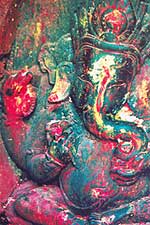 The work of the Indian artist, Prakaash Chandwadkar has undergone a steady transformation in the past two years. In the group show Artists Without Borders, Prakaash's paintings stood out through their unfolding energy.
The work of the Indian artist, Prakaash Chandwadkar has undergone a steady transformation in the past two years. In the group show Artists Without Borders, Prakaash's paintings stood out through their unfolding energy. rakaash embodied himself through the repeated thrust of the brush and a persistent outpouring of colour. In his next two shows at the Siddhartha Gallery-Bodhi Leaves and Bamiyan Buddha-Prakaash relied on the steady presence of a single field of colour and the locating force of Buddhist symbol.
Prakaash's temperament cooled down; his chaotic diaspora of colour held to the centre and a presence of peace emanated from his work. In Shakti-Sthal Prakaash attempts to integrate these two strategies. Embodied energy and placating space meet in these works. The signifying presence of Hindu and Buddhist symbols place the viewer in a centrifugal field of colour within or near cloud banks of centripetal brush strokes. Each painting has a quality of its own, but the display as a whole establishes a space that is both contemplative and expressive. The repetition of symbols across the boundaries of the paintings seduces the viewer into believing in the redemptive power and beauty of painting.
The matrix for this work is Kathmandu Valley. For the Bamiyan Buddha exhibit Prakaash took hundreds of photos of Buddhas located throughout the Valley. These he set in his paintings. For Shakti-Sthal Prakaash visited the power places to photograph idol, stone, tree root, shrine, niche and alcove-wherever the hand of the worshipper could be seen. Hundreds of photos representing these intimate sources of power also figure in this multifaceted exhibit. Where the worshipper offers powder, blood or the touch of her hand in rites of worship, Prakaash paints. The immediate force of that which is worshipped is diminished and yet reclaimed. With the photos the presence of the Shakti-Sthal almost manifests itself. To bring forth the power of the stone-shaped gods and the colourful blessings of puja, Prakaash has printed in vinyl 4x5 foot enlargements of the smaller idols. With these images as with the paintings, beauty usurps innate force and the contemplative power of the intellect demands appreciation rather than worship.
It may be that Prakaash wishes to extend this reclamation to the very space of the gallery. Attempting to establish a contemporary Shakti-Sthal, Prakaash has set, within the forest of his paintings and photos, a brass lingam in a mandala of water surrounded by four televisions screening images of a man and a woman (Wang Sai Kwan and Sujata Sitoula) dancing. Does this improvised shrine and dance suggest the secular equivalent of worship? On the second floor of the gallery Prakaash's brass lingam has grown in height-this time surrounded by an encampment of photos. For the casual onlooker an exhibit of painting, photography, sculpture and installation in a gallery setting evokes not the awe-felt immediacy of devotion but the smile that accompanies an aesthetic sense of pleasure. When the power gained through contact with the Valley's Buddhas and Hindu deities manifests through the muted energy of his brush work, where the matrix of that encounter remains in the paintings and through the interplay of the depicted icons, Prakaash's work becomes a Shakti-Sthal.


